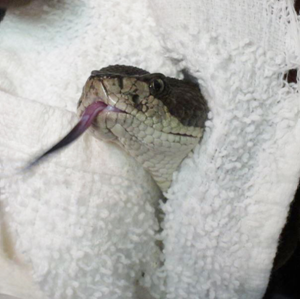
Photo by WildCare
WildCare runs a hospital and rehabilitation center for sick and injured wildlife in San Rafael, California. Their telephone hotline helps concerned members of the public deal with wildlife emergencies.
WildCare is on the front lines of human/wildlife interaction. They treat more than 3,000 sick or injured animals each year. Many of these animals come to Wildcare as a result of hazards created unintentionally by humans in the environment.
A friend sent me this clip of WildCare staff treating an injured rattlesnake caught in someone’s garden netting. I found the video fascinating and thought it might interest you, too. Needless to say, the snake is throwing a hissy-fit! 😀
WildCare provides a written description of the treatment:
… it became clear that the netting was not just wrapped around the animal’s body, it was also in his mouth! Fortunately some gentle pulling allowed Nat to remove the plastic from the snake’s jaws. Then Director of Animal Care, Melanie Piazza carefully snipped the netting away from the snake’s body.
Injuries caused by entanglement present in different ways on a snake than they do on mammals or birds. Because their scales are strong but also flexible, the netting doesn’t always break through them, so there often aren’t open wounds that need treatment the way there would be on another entangled animal. Instead most of the injuries on a snake are compression injuries, which are much harder to diagnose. Examining the snake, it was obvious where the material had compressed and squeezed the snake’s body, but it wasn’t clear how much damage to internal organs or deep tissue may have resulted.
Even though no significant open wounds were found on this rattlesnake, once all the netting had been removed, Medical Staff placed him in a warm antiseptic soak to prevent any possibility of infection. Then he was given a quick injection of anti-inflammatory medication and placed in a heavily locked reptile enclosure.
The only way to really ascertain the damage the snake had suffered is to wait until the snake sheds his skin. Once the top layer of skin is gone, wounds present and the snake’s true injuries become clear. Keeping a rattlesnake in a rehabilitation setting can be a challenge, but fortunately a WildCare volunteer built us specially-designed caging for patients like this one. The cage is escape-proof and lockable. The snake was placed in this secure cage to rest and, in the next week or so, shed his skin.
Have you ever rescued injured or sick wildlife? Have you volunteered to do wildlife rescue? Share your experience in the comments below.
More Snakes on NatureOutside:
Mountain Kingsnake – Beauty and Danger!
Gopher Snake – Master Impersonator!
Excuse me while I whip this out!



Leave a Comment